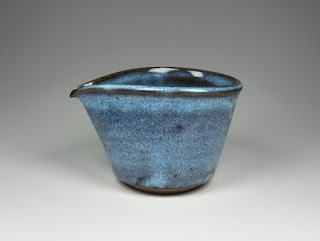白岩焼のふるさとを訪ねて Visiting Shiraiwa Pottery's Hometown
先月、電車を途中下車して秋田県仙北市の角館に立ち寄った。滞在できる時間が短かったのでタクシーでまわろうかとおもっていたが、角館駅前に「貸自転車」の看板をみつけたのでそれを利用することにした。
I stopped off at Kakunodate, Semboku City, Akita, last month. I was going to take a taxi to move around the city during a limited time, but changed my mind when seeing a signboard of "rental bike" in front of Kakunodate station.
角館樺細工伝承館 Kakunodate Kaba-zaiku Museum
樺細工とは桜の樹皮を貼りつけて装飾した器物のことで、堅牢で独特の光沢がある。茶筒をはじめとしてさまざまな製品があり、角館の特産品になっている。ここは樺細工の伝統を広く知ってもらうための市の施設で、樺細工の製法の紹介、職人さんの実演コーナー、製品の展示と販売、などが主な内容となっている。樺細工以外の地元の工芸品や歴史的な遺物も収集しており、広い意味での歴史・民俗資料館でもある。
Kaba-zaiku means a wooden object decorated with a cherry tree's bark, by which it becomes strong and lustrous. There are many products such as a tea canister, and it is one of the specialities of Kakunodate. This is a public museum aiming to explain how to create kaba-zaiku especially by real craftsman's works and to display and sell products. The museum also collects and displays other craft products and historical materials.
Old Shiraiwa wares at Kakunodate Kaba-zaiku Museum. There are roughly two types of namako glaze. The white one is generally old and the blue is new. The green glaze is rare.
ちょうど「角館の伝統工芸品展」と題する特別展が開催中で、江戸から明治にかけての古い白岩焼のコレクション20点ほどが紹介されていた。白岩焼には大雑把に2系統の製品群がある。ひとつは褐色の下釉の上に白もしくは青白いなまこ釉をかけたすず(徳利)やかめなどの日用品で、江戸後期から明治期にかけて大量につくられた。もうひとつは職人が相当の手間をかけてつくったと考えられる少数生産品で、とくに全体が茶褐色でさまざまな文様を線刻であらわした器が代表的である。中には作者の銘が入っているものがあり、美術的のみならず資料的にも重要視されている。やはり後者の希少品が展示の中心ではあったが、先日このブログで紹介したなまこ釉の小さなすずの類似品なども展示されていて、とても興味深かった。
特別展の会期は2023年10月1日まで。白岩焼の特別展示は例年夏の時期にやっているようである。詳細は仙北市のホームページを参照のこと。
I saw a special exhibition of the traditional craft works in the Kakunodate region, where about twenty Shiraiwa wares made in the Edo to Meiji periods (19th century) were displayed. The Shiraiwa wares can be classified into two groups. One of them is a daily-use bottle and jar decorated with brown and namako (blue or white) glazes. Another is a specially made mostly brown vessel with some engraved patterns, which is rare and is treated as not only artistically but historically important materials because potter's name was engraved in some products. A namako-glaze small bottle was especially interesting for me because there is a similar bottle in my collection. This special exhibition lasts until October 1st, 2023. The museum's collection of old Shiraiwa ware seems to be displayed every summer season. See Semboku City's homepage for more detail.
白岩焼和兵衛窯 Shiraiwa Wahee Pottery
白岩焼はその名のとおり、角館の町から東に 5 km ほどの白岩地区(旧白岩村)でつくられたやきものである。18世紀後半にはじまり、最盛期で6箇所に登り窯があったというが、1900年頃までにはすべて途絶えてしまった。その後1970年代になって、窯元のひとつ勘左衛門窯のご子孫にあたる渡辺家の方々がやきものづくりを再興し、白岩焼和兵衛(わへい)窯として現在もご活躍である。
I visited Shiraiwa village, which is located about 5 km east of the center of Kakunodate and is the place where the Shiraiwa pottery began in the late 18th century. There were six kilns at the peak period but all of them closed by 1900. In 1970s, Watanabe family, a descendant of the Kanzaemon pottery that was one of the six Shiraiwa potteries, began firing ceramics again as the Shiraiwa Wahee pottery.
A lipped bowl of Shiraiwa Wahee pottery. It contains about 180 ml and will be convenient in drinking sake.
気温33℃の猛暑の中ママチャリを漕ぎこぎ、汗だくになりつつ 20 分ちょっとでその和兵衛窯に到着。ギャラリーにて製品を鑑賞させていただき、またいろいろお話をうかがって有意義であった。一般に白岩焼の特徴は青白いなまこ釉にあるといわれるが、わたしはそれに加えて褐色の下釉にも大いなる魅力を感じている。褐色と青白色との対比が秋田の風土やそこに住む人々の性格さえも体現しているようにおもう。
訪問の際はあらかじめ予約が必要である。連絡先等くわしいことは白岩焼和兵衛窯のホームページを参照のこと。
I rode a bicycle for 20 minutes or so under a high temperature condition of 33 ℃ to reach the Shiraiwa Wahee pottery. It was nice to see beautiful works and to hear interesting stories at the gallery. It is generally said that the most distinctive feature of the Shiraiwa ware is the blue namako glaze, but I have been fascinated at the brown underglaze too. I think the combination of blue and brown glazes reflects the nature and people in Akita.
古白岩焼の窯跡 Ruins of Old Shiraiwa Potteries
白岩地区の南東のはずれに窯跡があり、秋田県指定の史跡の標柱がたっている。18世紀後半、相馬の陶工松本運七が秋田に流れ着き、この地に窯を築いた。渡辺為吉「白岩瀬戸山」によれば、この場所には儀三郎窯(イ窯・上窯)、吉五郎窯(ロ窯・下窯)、多一郎窯(ホ窯)があった。また白岩の集落内にも勘左衛門窯(ハ窯)、孫兵衛窯(ニ窯)、吉十郎窯(ヘ窯)があった(イ〜ヘの記号は築窯の順)。和兵衛窯の方の話によると以前窯跡の発掘調査がなされたが、学術的な報告書は出ていないという。残念なことである。
There is a historic site of old Shiraiwa potteries at the southeast end of Shiraiwa village. In the late 18th century, a potter, Matsumoto Unshichi, moved from Soma, Fukushima, to Akita and built a kiln. Then, kilns were built there by three families; namely, Gisaburo (the first), Kichigoro (the second), and Taichiro (the fifth) potteries. There were also three kilns in the center of the village; Kanzaemon (the third), Magobee (the fourth), and Kichijuro (the sixth) potteries. An excavation investigation was once conducted here but academic reports have never been published.
雲巌寺(雲岩寺) Ungan-ji Temple
白岩地区には雲巌寺(うんがんじ)という大きなお寺がある。宝徳2年(1450年)創建の歴史あるお寺で、山門は秋田県有形文化財に指定されている(仙北市のホームページ)。江戸時代に白岩焼のお地蔵さまを千体つくってお寺に奉納したものがいまも残っていて、見学可能である。高さ 15 cm くらいの素焼き製。もっと大きいのかと思っていたが案外コンパクトに収まっていた。
There is a big temple, Ungan-ji, in Shiraiwa, which is said to be built in 1450. The gate in front of the temple is designated as a cultural asset of Akita. Thousand ceramic statues of jizo baked by Shiraiwa potteries in the late Edo period still remain in the temple, which can be seen basically freely. The statue was 15 cm in height. It was smaller than I thought. Those statues were compactly stored in a room.



